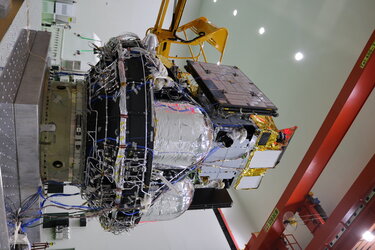

Smile during space environment testing
Between March and July 2025, Smile went through its ‘space environment testing’ phase at ESA’s technical heart, ESTEC, in the Netherlands. Engineers took the spacecraft through tough checks, needing it to pass with flying colours before being allowed out on its own.
Tests included making sure that the entire system can operate properly in the vacuum of space, that the different parts of the spacecraft don’t create too much electromagnetic disturbance for other parts, and that the rough launch won’t shake the spacecraft apart.
Smile (the Solar wind Magnetosphere Ionosphere Link Explorer) is a joint mission between the European Space Agency and the Chinese Academy of Sciences. Smile is due to launch on a European Vega-C rocket in 2026. Follow the latest mission news via esa.int/smile.
[Image description: A spacecraft inside a cleanroom environment. The spacecraft is suspended from thick red cords and is covered in gold-coloured thermal insulation material. Three people wearing protective helmets inspect the spacecraft; one of them carries a group of blue wires leading away from the spacecraft.]





